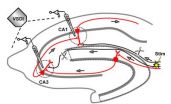(Press-News.org) This press release is available in German.
The hippocampus represents an important brain structure for learning. Scientists at the Max Planck Institute of Psychiatry in Munich discovered how it filters electrical neuronal signals through an input and output control, thus regulating learning and memory processes. Accordingly, effective signal transmission needs so-called theta-frequency impulses of the cerebral cortex. With a frequency of three to eight hertz, these impulses generate waves of electrical activity that propagate through the hippocampus. Impulses of a different frequency evoke no transmission, or only a much weaker one. Moreover, signal transmission in other areas of the brain through long-term potentiation (LTP), which is essential for learning, occurs only when the activity waves take place for a certain while. The scientists even have an explanation for why we are mentally more productive after drinking a cup of coffee or in an acute stress situation: in their experiments, caffeine and the stress hormone corticosterone boosted the activity flow.
When we learn and recall something, we have to concentrate on the relevant information and experience it again and again. Electrophysiological experiments in mice now show why this is the case. Scientists belonging to Matthias Eder´s Research Group measured the transmission of electrical impulses between neurons in the mouse hippocampus. Under the fluorescence microscope, they were able to observe in real time how the neurons forward signals.
Jens Stepan, a junior scientist at the Max Planck Institute of Psychiatry in Munich, stimulated the input region of the hippocampus the first time that specifically theta-frequency stimulations produce an effective impulse transmission across the hippocampal CA3/CA1 region. This finding is very important, as it is known from previous studies that theta-rhythmical neuronal activity in the entorhinal cortex always occurs when new information is taken up in a focused manner. With this finding, the researchers demonstrate that the hippocampus highly selectively reacts to the entorhinal signals. Obviously, it can distinguish important and, thus, potentially recollection-worth information from unimportant one and process it in a physiologically specific manner.
One possible reaction is the formation of the so-called long-term potentiation (LTP) of signal transmission at CA3-CA1 synapses, which is often essential for learning and memory. The present study documents that this CA1-LTP occurs only when the activity waves through the hippocampus take place for a certain time. Translating this to our learning behavior, to commit for instance an image to memory, we should intently view it for a while, as only then we produce the activity waves described long enough to store the image in our brain.
With this study, Matthias Eder and colleagues succeeded in closing a knowledge gap. "Our investigation on neuronal communication via the hippocampal trisynaptic circuit provides us with a new understanding of learning in the living organism. We are the first to show that long-term potentiation depends on the frequency and persistency of incoming sensory signals in the hippocampus," says Matthias Eder.
INFORMATION:
Original publication:
Jens Stepan, Julien Dine, Thomas Fenzl, Stephanie A. Polta, Gregor von Wolff, Carsten T. Wotjak and Matthias Eder (2012) Entorhinal theta-frequency input to the dentate gyrus trisynaptically evokes hippocampal CA1 LTP, Frontiers in Neural Circuits, Volume 6, Article 64, 1-13.
Learning requires rhythmical activity of neurons
Memory-forming signal transmission in the hippocampus elucidated
2012-09-26
ELSE PRESS RELEASES FROM THIS DATE:
New AACP Practice Parameter on gay, lesbian, bisexual, and gender variant issues
2012-09-26
Washington D.C., September 26, 2012 – The American Academy of Child and Adolescent Psychiatry (AACAP) is proud to announce its new Practice Parameter on issues related to and affecting gay, lesbian, bisexual, and gender variant youth.
Gay, lesbian, bisexual, and gender variant children and adolescents face unique developmental challenges and stressors that can influence their mental health and wellbeing. Social issues such as stigma, bullying, and discrimination, and personal factors like internalized prejudice and feelings of being different are just a few of the concerns ...
Melatonin and exercise work against Alzheimer's in mice
2012-09-26
The combination of two neuroprotective therapies, voluntary physical exercise, and the daily intake of melatonin has been shown to have a synergistic effect against brain deterioration in rodents with three different mutations of Alzheimer's disease.
A study carried out by a group of researchers from the Barcelona Biomedical Research Institute (IIBB), in collaboration with the University of Granada and the Autonomous University of Barcelona, shows the combined effect of neuroprotective therapies against Alzheimer's in mice.
Daily voluntary exercise and daily intake ...
New simulation method produces realistic fluid movements
2012-09-26
What does a yoghurt look like over time? The food industry will soon be able to answer this question using a new fluid simulation tool developed by the Department of Computer Science (DIKU) at the University of Copenhagen as part of a broad partnership with other research institutions. An epoch-making shift in the way we simulate the physical world is now a reality.
A five-year collaboration between the University of Copenhagen, the Technical University of Denmark (DTU) and the Alexandra Institute on simulating fluids in movement is now bearing fruit, and has earned the ...
How is a Kindle like a cuttlefish
2012-09-26
Over millions of years, biological organisms – from the chameleon and cuttlefish to the octopus and squid – have developed color-changing abilities for adaptive concealment (e.g., camouflage) and communication signaling (e.g., warning or mating cues).
Over the past two decades, humans have begun to develop sophisticated e-Paper technology in electronic devices that reflect and draw upon the ambient light around you to create multiple colors, contrast and diffusion to communicate text and images.
And given the more than 100 million years head start that evolution has ...
Reducing acrylamide levels in french fries
2012-09-26
The process for preparing frozen, par-fried potato strips — distributed to some food outlets for making french fries — can influence the formation of acrylamide in the fries that people eat, a new study has found. Published in ACS' Journal of Agricultural and Food Chemistry, the study identifies potential ways of reducing levels of acrylamide, which the National Toxicology Program and the International Agency for Research on Cancer regard as a "probable human carcinogen."
Acrylamide forms naturally during the cooking of many food products. Donald S. Mottram and colleagues ...
Preserving large females could prevent overfishing of Atlantic cod
2012-09-26
Cod are among Sweden's most common and most popular edible fish and have been fished hard for many years. One consequence is the risk of serious changes in cod stocks, reveals research from the University of Gothenburg, Sweden.
In overfished areas, there is often a shortage of large and old cod, and the fish become sexually mature at a younger age. Researchers have feared that this change may have impacted on the fish's health, physiological ageing and reproductive capacity.
In a recently published study, a research group from the University of Gothenburg working with ...
Date palm juice: A potential new 'green' anti-corrosion agent for aerospace industry
2012-09-26
The search for a "greener" way to prevent corrosion on the kind of aluminum used in jetliners, cars and other products has led scientists to an unlikely source, according to a report in ACS' journal Industrial & Engineering Chemistry Research. It's the juice of the date palm — those tall, majestic trees that, until now, were noted mainly as sources of food and traditional medicines.
Husnu Gerengi points out that strong, lightweight aluminum alloys are used to make planes, cars and industrial equipment. Aluminum corrodes when exposed to air, but unlike rusting steel, the ...
Study looks at risk factors for HIV in US Navy and Marines during 'Don't Ask, Don't Tell'
2012-09-26
Philadelphia, Pa. (September 26, 2012) – Same-sex partners and inconsistent condom use were among the major risk factors for HIV infection among U.S. Navy and Marines personnel during the "Don't Ask, Don't Tell" (DADT) era, reports a study in the October 1 issue of JAIDS: Journal of Acquired Immune Deficiency Syndromes. The journal is published by Lippincott Williams & Wilkins, a part of Wolters Kluwer Health.
"[M]ale-to-male sexual contact was a much more common mode of infection than previously reported," reports the new study, led by Shilpa Hakre, DrPH, MPH, of the ...
Researchers develop blood test that accurately detects early stages of lung, breast cancer in humans
2012-09-26
MANHATTAN, Kan. -- Researchers at Kansas State University have developed a simple blood test that can accurately detect the beginning stages of cancer.
In less than an hour, the test can detect breast cancer and non-small cell lung cancer -- the most common type of lung cancer -- before symptoms like coughing and weight loss start. The researchers anticipate testing for the early stages of pancreatic cancer shortly.
The test was developed by Stefan Bossmann, professor of chemistry, and Deryl Troyer, professor of anatomy and physiology. Both are also researchers affiliated ...
A birth control pill for men? When?
2012-09-26
When will men have their own birth control pill? Scientists have been predicting the debut of a male pill within 5 years for the last 30 years. The factors accounting for that delay — and new optimism that a male pill will emerge within a decade — are the topic of a story in the current edition of Chemical & Engineering News. C&EN is the weekly newsmagazine of the American Chemical Society, the world's largest scientific society.
In the story, Michael M. Torrice, C&EN associate editor, describes the need for a male version of the oral contraceptive pill that revolutionized ...
LAST 30 PRESS RELEASES:
Why nail-biting, procrastination and other self-sabotaging behaviors are rooted in survival instincts
Regional variations in mechanical properties of porcine leptomeninges
Artificial empathy in therapy and healthcare: advancements in interpersonal interaction technologies
Why some brains switch gears more efficiently than others
UVA’s Jundong Li wins ICDM’S 2025 Tao Li Award for data mining, machine learning
UVA’s low-power, high-performance computer power player Mircea Stan earns National Academy of Inventors fellowship
Not playing by the rules: USU researcher explores filamentous algae dynamics in rivers
Do our body clocks influence our risk of dementia?
Anthropologists offer new evidence of bipedalism in long-debated fossil discovery
Safer receipt paper from wood
Dosage-sensitive genes suggest no whole-genome duplications in ancestral angiosperm
First ancient human herpesvirus genomes document their deep history with humans
Why Some Bacteria Survive Antibiotics and How to Stop Them - New study reveals that bacteria can survive antibiotic treatment through two fundamentally different “shutdown modes”
UCLA study links scar healing to dangerous placenta condition
CHANGE-seq-BE finds off-target changes in the genome from base editors
The Journal of Nuclear Medicine Ahead-of-Print Tip Sheet: January 2, 2026
Delayed or absent first dose of measles, mumps, and rubella vaccination
Trends in US preterm birth rates by household income and race and ethnicity
Study identifies potential biomarker linked to progression and brain inflammation in multiple sclerosis
Many mothers in Norway do not show up for postnatal check-ups
Researchers want to find out why quick clay is so unstable
Superradiant spins show teamwork at the quantum scale
Cleveland Clinic Research links tumor bacteria to immunotherapy resistance in head and neck cancer
First Editorial of 2026: Resisting AI slop
Joint ground- and space-based observations reveal Saturn-mass rogue planet
Inheritable genetic variant offers protection against blood cancer risk and progression
Pigs settled Pacific islands alongside early human voyagers
A Coral reef’s daily pulse reshapes microbes in surrounding waters
EAST Tokamak experiments exceed plasma density limit, offering new approach to fusion ignition
Groundbreaking discovery reveals Africa’s oldest cremation pyre and complex ritual practices
[Press-News.org] Learning requires rhythmical activity of neuronsMemory-forming signal transmission in the hippocampus elucidated


